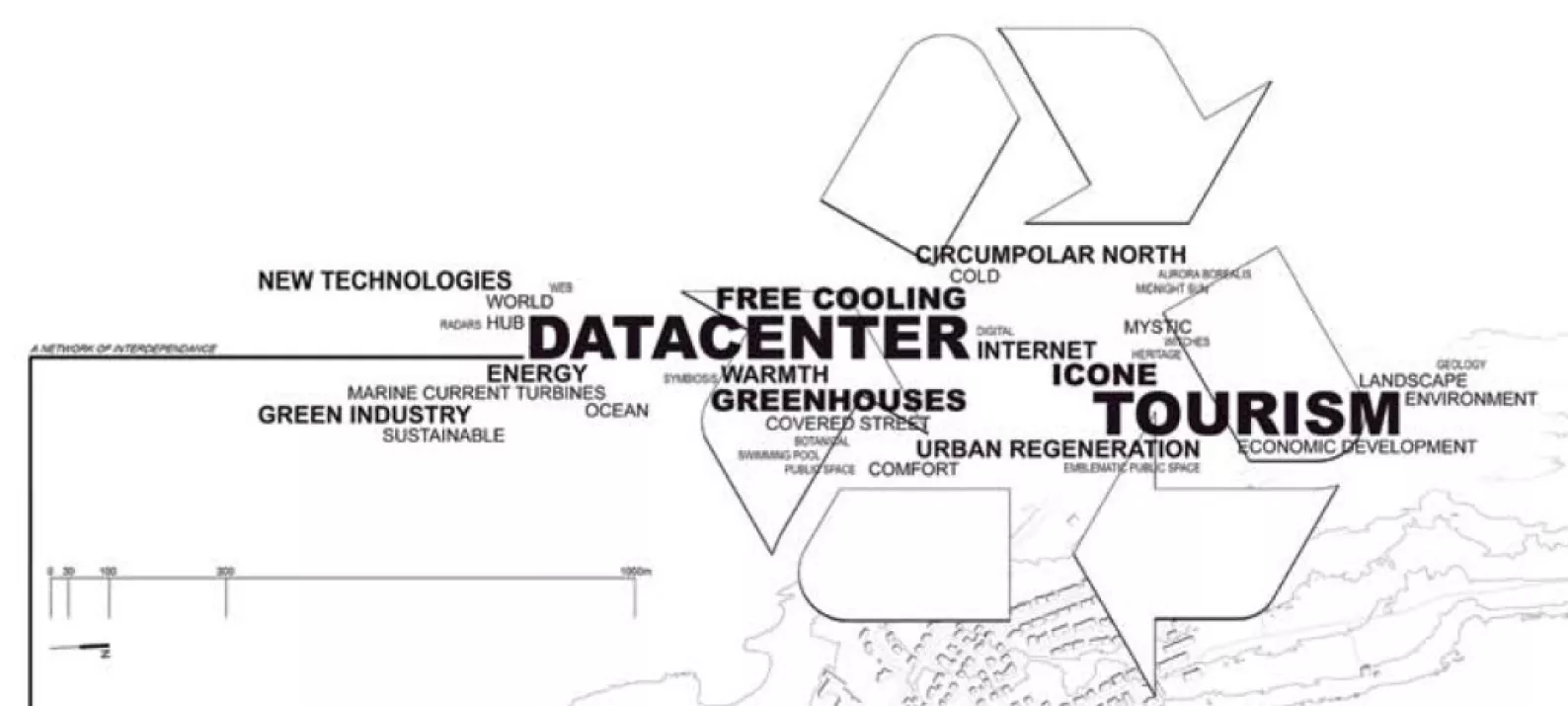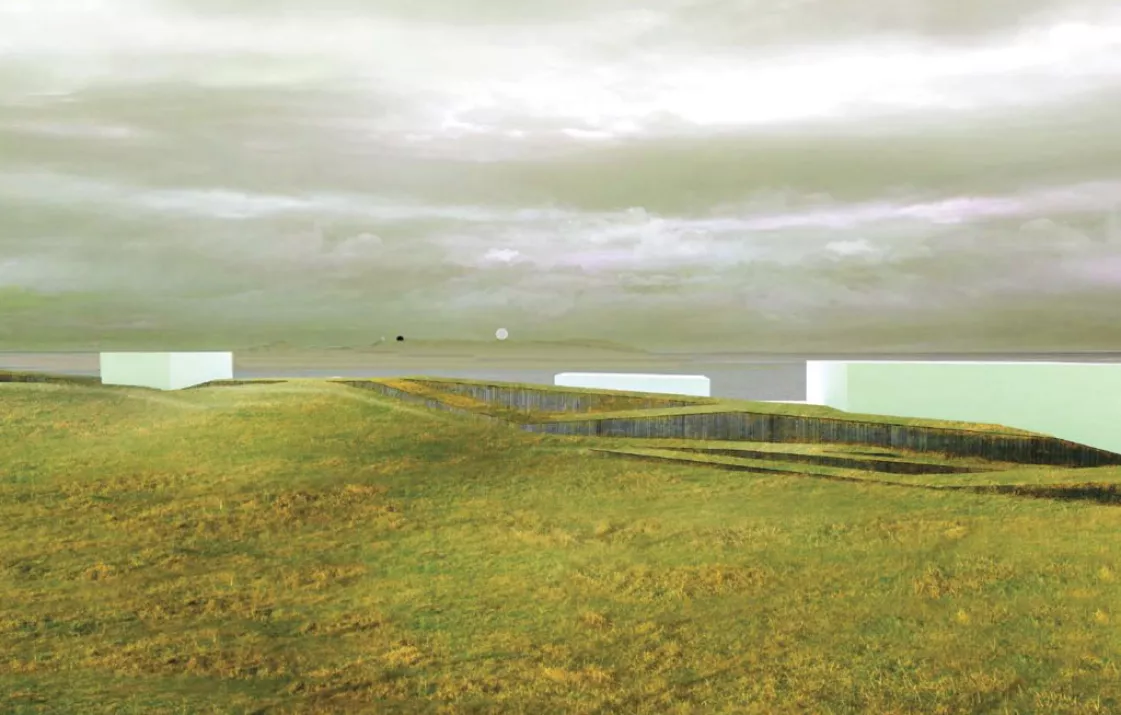Project:
Datarock
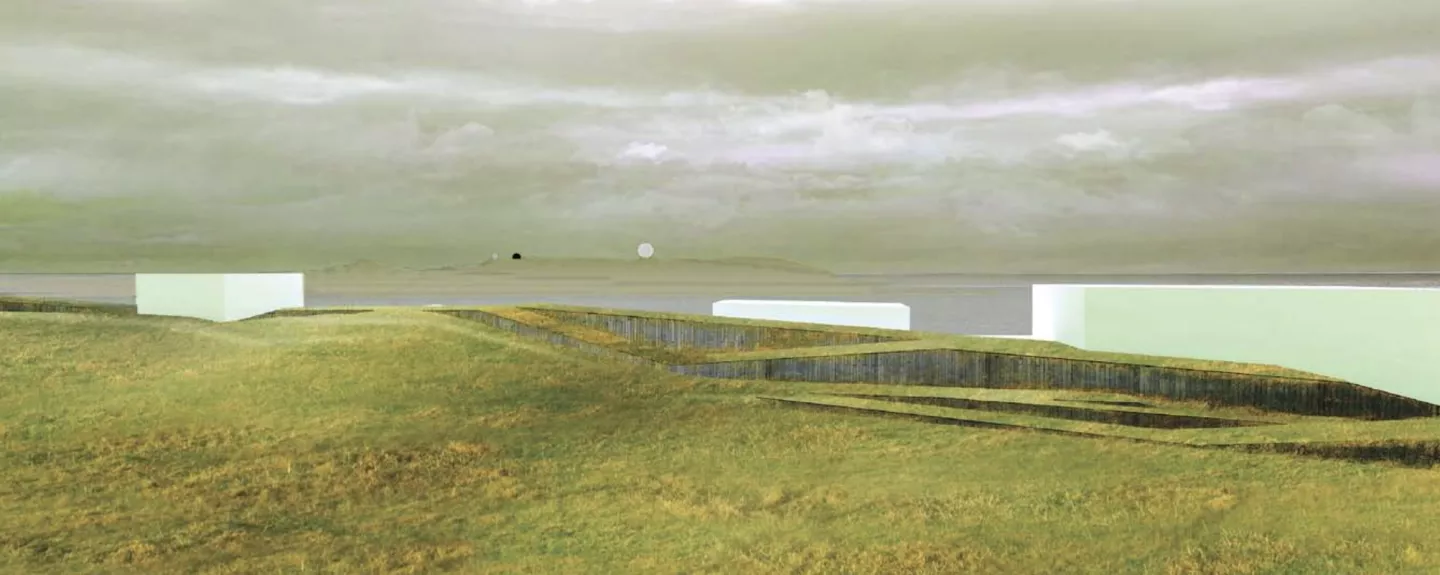
About
-
Tomorrow’s city is not an impenetrable partitioning of activities, inherited from functional town-planning. It is not the sum of lined up elements. Tomorrow’s city, the sustainable city, is a network of interdependence activities, uses and contexts, all interacting through more or less complex combinations. This process has to be engaged in Vardø. We suggest the creation of a new industry on Vardø: a datacentre. We would like to prove that when an industrial activity is related to a context and a specific environment, it becomes part of a cycle of interaction for the benefit of a sustainable city.
LOCATION
Vardø is located in an extreme territory at the northern tip of Norway, within the Arctic Circle and on the border of the inhabitable world; it is a location that is just as fascinating as hard to cope with.
At a time of globalisation and economic rationalism, the question for Vardø at the dawn of the 21st century is what can be done to avoid its outermost position from turning into a marginalized one?
The aim is to show that Vardø does not stand aside, but on the contrary is the pioneer of a process. Vardø can be the laboratory that will allow us to imagine new strategies of development, sustainable strategies this time.INTERNET
Internet is the networking of a prodigious accumulation of information and knowledge; an endless list of 0s and 1s.The risk for tomorrow is lacking the energy required to store this huge mass of information permanently. If nothing is done, the worldwide data processing capacity will inevitably lead to a shortage of energy, an over-consumption of non renewable resources and consequently a worsening of pollution.
Data is stored in servers located in datacentres scattered all over our planet. These centres operate unceasingly and, as one can see at home with one’s personal computer, the machines heat up fast and strong. Each transaction the datacentre processes consumes energy and therefore gives out heat.
In 2007 the datacentres consumed 183billion Kw/hour; a figure that will double in the next 5 years. To meet demands, 200 more nuclear power stations would be needed in the next 20 years.FREE COOLING
A datacentre needs to cool down its servers continuously to keep the temperature around 20° C. Overheating causes breakdown and is inevitable unless cooling systems operate continuously. The electricity bill is colossal, and even more so when the datacentre is located in a hot region.
This electricity bill needs to be reduced. Google is currently considering setting up their datacentres out at sea so as to use sea water for the cooling systems. Microsoft is considering cold regions like Iceland or Siberia with the same cooling possibilities in mind. Natural lowering of temperature by only 2 degrees inside a datacenter can entail a 30% decrease in energy consumption. Using this technique of natural cooling, the geographical and weather conditions (the cold) have a direct impact on energy consumption and by extension industrial activities.RECYCLING
Could unwanted heat be re-used? In cold climates, such heat could be useful. In Stockholm for example; the heat produced by the 200,000 travellers walking through the central station daily is regained via a ventilation system and used for heating a nearby building120 hosting offices, boutiques, restaurants and hotels. The cold weather context is the answer to the over-production of heat, the same heat can be used for the daily needs of the inhabitants of Vardø.
AN ICON
A “green” industry in a sustainable city can perfectly interact with tourism. Better still, industrial activity can become a tourist attraction! How? Through the image that emanates from it. Paradoxically, despite its colossal power, the Internet does not show a familiar image. The time has come to devise an icon.
What is the Internet exactly? Pointing to a corrugated iron shed topped with huge cooling towers would be a bit dull, wouldn’t it? So, what exactly is the Internet?“You’ll find it near the North Pole. It’s very cold out there, the sun never sets sometimes, or never rises... it’s as it pleases. All is white, immaculate; it is the garden of witches, of giants. It’s a pagan world in the Northern lights – aurora borealis. The Internet lies on the Isle of Vardø in the north of Norway, on the Arctic Ocean. It’s an extraordinary island which is well worth a visit”
Following already most popular digital culture, we are now inventing digital tourism.To make the new Vardø datacentre become an international icon, our scale of intervention is a whole territory on the World Wide Web scale; a wide enough scale to account for the phenomenal importance of the Internet in our society. Dramatically located at the extreme point of the southern basin, this datacentre is a piece of an island; a unique island at the junction of Europe, America and Asia. We are on an ideal hub of communication, a strategic place. Vardø datacentre looks like a landscape-building: half buried, half submerged; it is a mimetic implant of the local geological layers. By analogy, it is as if the data was stored in the ground. Energy springs from the ground. Digi- tal data is a resource just like oil or coal, but it is renewable. From this rock emerge three luminous cubes, three signals at the end of the island, slightly outside the city as a lighthouse would. On the other side, the road out of the tunnel goes astray. A semi-mineral park – a “Data Park” – replaces it and stretches the strati- fied geomorphology of the datacentre towards the new Major Plaza. The new Plaza is symbolically located at the junction of the two islands, in the heart of the basins. This area, free from automobile traffic in its southern part, becomes a belvedere on the south basin, a starting point for tourist promenades, a real urban place as well as an observation point to the Internet.
NEW PUBLIC SPACE
This new activity space will have an important impact on economy and consequently on the shape of the city. It is too soon to suggest a definitive set vision for Vardø’s future town-planning. The question raised here, as in every harbour area all over the world, is how can the activity of the harbour, a guarantee of its identity, be conciliated with its public use? How can the town be linked to the busy harbour? Bearing in mind that the rehabilitation of the existing buildings requires sharp individual analysis, what we propose for the moment is to create a structure to frame the future urban development.Along the main shopping street on the west quay of the harbour, five glass houses providing indoor public spaces are set on a line in the axis of the existing road network. Sheltered from wind and other elements, these spaces are heated by geothermal exchange via the datacentre,with almost free and plentiful energy.
NEW SOCIAL LIFE
There is no question of totally transforming the harbour; we consider it indispensible to keep the existing buildings whenever possible – at least in their materiality and volume – so as to maintain the identity of Vardø harbour.
These purposely identical, strict and majestic glazed spaces do not make sense unless standing there, right in this obsolete chaos. It is the accumulation, the his- torical juxtaposition that gives birth to the new image of Vardø.
Side by side with the existing buildings, either rehabilitated or rebuilt, the glass houses host or lead to the various developing programs granting them outstanding heat performance. They are neither streets nor access halls but urban interstices in the harbour area: windows allowing the city to get closer to the water and harbour activities. Inside, whatever the season, you can enjoy open-air life, plants, terraces, and the pleasure of stripping off your big parka because it is nicely warm.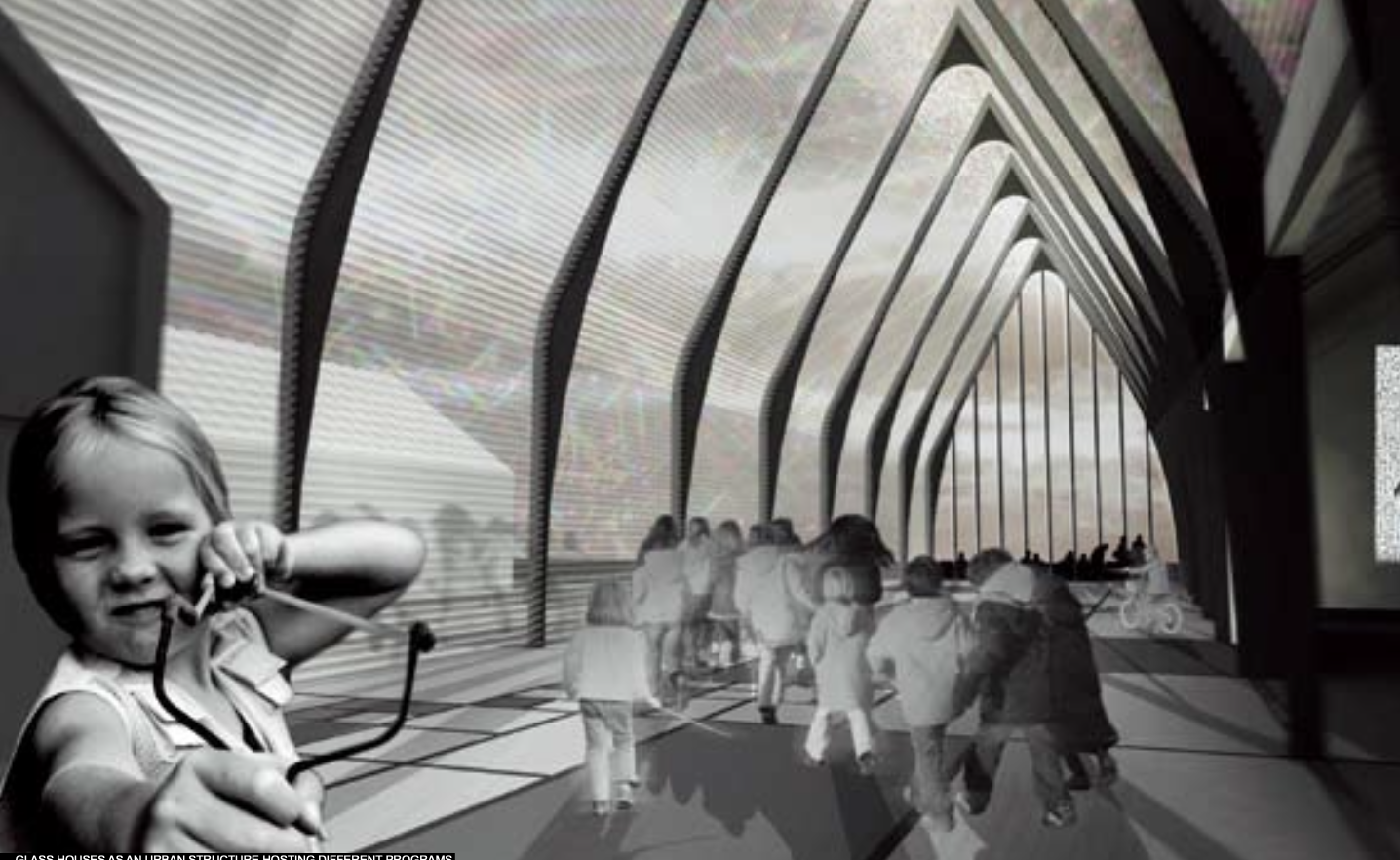
-
Datarock is a bold and forward-looking proposal that turns the daunting remoteness and Arctic climate of the city into its biggest advantage, while at the same time providing an answer to the world’s ever-growing need for the storage of digital data. In fact, Datarock suggests the creation of a brand new industry for the area: the data centre . Also called a ‘server farm’, a data centre is a facility that stores digital information made available on the Internet. Far from being as intangible as the goods they store, these infrastructures require huge amounts of energy to cool down. Installing them in extremely cold but inhabitable regions is therefore a natural solution.
Datarock is not designed to function as a separate entity, but rather to service Vardø. The warmth continuously produced by the data centre would be used to heat new and existing public spaces while answering the daily needs of the city’s inhabitants. The data centre itself is fused within the landscape; half buried, half submerged, it appears on the horizon like a rock from which three luminous cubes emerge. Located on the edge of the city limits, it evokes the atmosphere of a lighthouse.
Interestingly, the project proposes that this new industry would create a new form of ’digital tourism’ in Vardø. People will flock to see the material face of the Internet, while sustainable energy practices will exploit the heat produced by the massive machines for various facilities in the area.
-
Gauthier Le Romancer is an architect, born in 1980 in Lorient, France. He graduated from the Paris Val-de- Seine School of Architecture in 2005. He has worked in various agencies in Barcelona, Montreal and Par- is and has now been an independent architect for 2 years.
Guillaume Derrien is a landscape architect, born in 1979 in Brest France. He studied Art and Architec- ture before graduating as a landscape architect from the National School of Versailles in 2004. A project manager for several years in the Paris agen- cy TNplus, he now practices as an independent land- scape architect.
The two join regularly for international competitions under the name, “La Plage Architecture et Paysage”. They were awarded a mention for “Venice Lagoon Park” (IT-2008) and 1st prize for “Reinventing Grand Army Plaza” in Brooklyn (NY/USA-2008).
CONTACT
Guillaume Derrien / Landscape architect
41 rue des Envierges, 75020, Paris, FranceGauthier Le Romancer / Architect
10 Résidence de Keriel 56270, Ploemeur, Francewww.laplagearchitectureetpaysage.com
Related projects
-
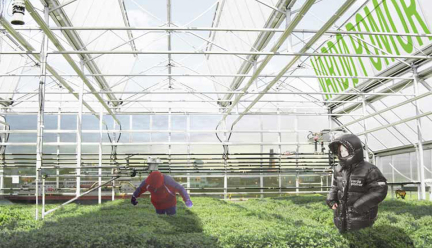
Repositioning the remote
Vardø is intrinsically linked to the Barents Sea. The future of the Arctic waters will drive either…
-
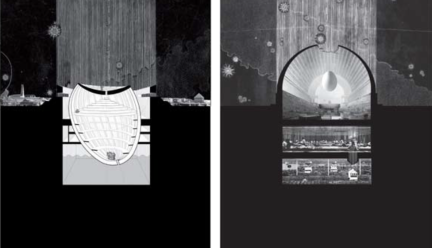
The white
Could we imagine an economically sustainable future for Vardø other than a touristic resort,…
-

Datarock
Tomorrow’s city is not an impenetrable partitioning of activities, inherited from functional…
